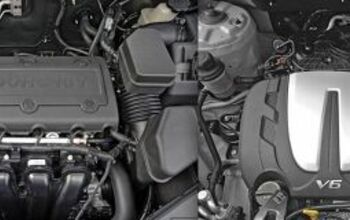Toyota Unveils New Duo Of Fuel-Efficient Engines
Toyota has unveiled this week two new fuel-efficient gasoline engines that will serve as the basis for as many as 14 global powerplants by 2015, and boost economy by 10 percent.
Automotive News reports the two engines — 1.3-liter four-pot and 1-liter three-pot — are Atkinson cycle powerplants co-developed with partner Daihatsu, and feature fuel-efficiency goodies such as EGR, VVT and stop-start technology.
On the power front — especially since Atkinson cycle engines are more known for their efficiency than for destroying ‘Ring times — the Toyota engines will deliver high compression ratios of 13.5 for the larger engine, 11.5 for the smaller. In turn, thermal efficiency in the duo will hit a maximum of 38 percent and 37 percent, respectively.
As for where the duo and their children will reside, expect the home market to have the first crack via the automaker’s line of non-hybrid compacts before taking the global stage the following year in both non-hybrid and hybrid vehicles, as well as larger premium offerings.
Seattle-based writer, blogger, and photographer for many a publication. Born in Louisville. Raised in Kansas. Where I lay my head is home.
More by Cameron Aubernon
Latest Car Reviews
Read moreLatest Product Reviews
Read moreRecent Comments
- MaintenanceCosts Nobody here seems to acknowledge that there are multiple use cases for cars.Some people spend all their time driving all over the country and need every mile and minute of time savings. ICE cars are better for them right now.Some people only drive locally and fly when they travel. For them, there's probably a range number that works, and they don't really need more. For the uses for which we use our EV, that would be around 150 miles. The other thing about a low range requirement is it can make 120V charging viable. If you don't drive more than an average of about 40 miles/day, you can probably get enough electrons through a wall outlet. We spent over two years charging our Bolt only through 120V, while our house was getting rebuilt, and never had an issue.Those are extremes. There are all sorts of use cases in between, which probably represent the majority of drivers. For some users, what's needed is more range. But I think for most users, what's needed is better charging. Retrofit apartment garages like Tim's with 240V outlets at every spot. Install more L3 chargers in supermarket parking lots and alongside gas stations. Make chargers that work like Tesla Superchargers as ubiquitous as gas stations, and EV charging will not be an issue for most users.
- MaintenanceCosts I don't have an opinion on whether any one plant unionizing is the right answer, but the employees sure need to have the right to organize. Unions or the credible threat of unionization are the only thing, history has proven, that can keep employers honest. Without it, we've seen over and over, the employers have complete power over the workers and feel free to exploit the workers however they see fit. (And don't tell me "oh, the workers can just leave" - in an oligopolistic industry, working conditions quickly converge, and there's not another employer right around the corner.)
- Kjhkjlhkjhkljh kljhjkhjklhkjh [h3]Wake me up when it is a 1989 635Csi with a M88/3[/h3]
- BrandX "I can charge using the 240V outlets, sure, but it’s slow."No it's not. That's what all home chargers use - 240V.
- Jalop1991 does the odometer represent itself in an analog fashion? Will the numbers roll slowly and stop wherever, or do they just blink to the next number like any old boring modern car?


































Comments
Join the conversation
So Toyota has finally decided to challenge Honda in the lawnmower segment.
Sentence found in another TTAC thread: "Buying an entry level car in India is more a choice between replacing a motorcycle/scooter" and I would say, most of southeast Asia, Africa and many countries in south America. Toyota will hit a homerun on those markets.